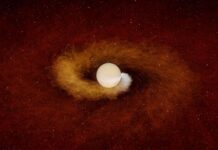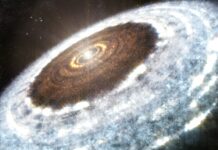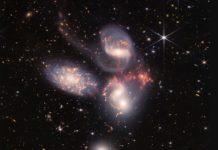Astronomers have recently discovered a larger than expected number of hypervelocity stars passing through our galaxy. A few of these stars are now on course to exit the galaxy, while a others appear to be entering the galaxy, possibly after being ejected from other nearby galaxies.
When you think of the term “hypervelocity star”, you may picture a crashed Ferrari, or perhaps a drunken actor storming off a movie set. Now instead picture the estimated 250+ billion stars of the Milky Way all revolving together in lock step around the center of our galaxy. But then, traveling on a path of its own, a star flies by at an unimaginable speed of 5 million miles per hour. That is a hypervelocity star.
Stars moving this fast have attained enough speed to escape the gravity of the Milky Way and are on course to exit the galaxy. Such stars are exceedingly rare. While the trajectory of some of these hypervelocity stars can be traced back to the main disk of our own galaxy, astronomers have found still others that are passing through the galaxy on trajectories that appear to have originated either outside the galaxy or, possibly in the Milky Way’s outer halo of stars.
Astronomers have identified these hyper velocity stars by examining data published by the European Space Agency’s Gaia satellite project. This project recently released data from a study of approximately 7 million nearby stars that were bright enough to allow researchers to plot their motion.
Of the approximately 7 million stars whose motion has been studied (a tiny fraction of the galaxy’s estimated 250 billion stars), a total of 20 hyper velocity stars were identified; 7 were identified as having begun their journey from within the main disk of the milky way, and another 13 are appear to be entering the galaxy from other nearby galaxies, or perhaps some of them have been launched inwards from the galaxy’s outer halo of stars.
 Astronomers will now begin to more closely examine the stars that are entering the galaxy from parts unknown. It is believed that stars from other galaxies may have a different chemical signature than stars that began their journey from the Milky Ways outer halo.
Astronomers will now begin to more closely examine the stars that are entering the galaxy from parts unknown. It is believed that stars from other galaxies may have a different chemical signature than stars that began their journey from the Milky Ways outer halo.
To be sure, there is a lot more to be learned from the well spring of data coming from the European Space Agency’s Gaia mission.










